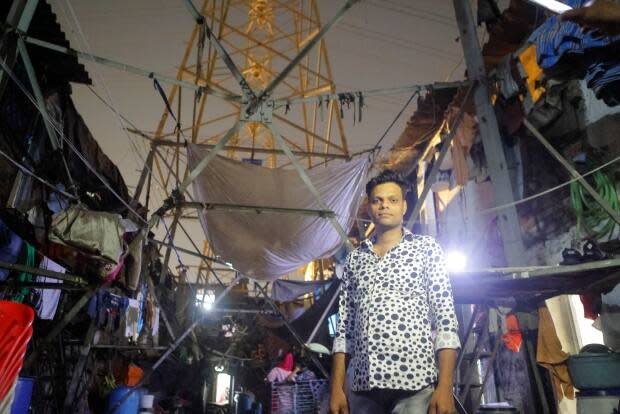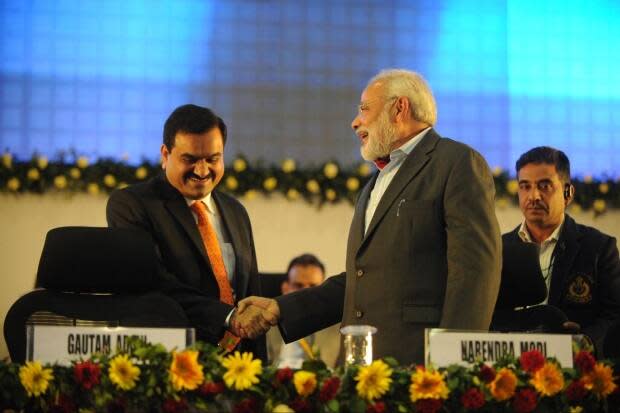Redevelopment in the slum from Slumdog Millionaire has residents worried they'll be forced out

Residents of Dharavi, India's largest slum, are worried about a new development project headed up by billionaire Gautam Adani — one that might see thousands of residents displaced.
Dharavi, depicted in the 2008 Oscar-winning movie Slumdog Millionaire, sits in the heart of Mumbai, the country's financial capital, and is home to about a million people. They may live in huts and shanties squeezed into the small piece of land smaller than Central Park, but theirs is a self-sustaining neighbourhood.
In Dharavi, kids run around and play — and thousands of businesses established over the years are thriving under the care of migrant workers. But right now, many of them are worried that they might lose it all.
In November, Adani and his company Adani Realty won a bid to redevelop Dharavi. Over the years, the area evolved from a mangrove swamp, to a fishing community and then a slum with poor infrastructure. The company's $2.4-billion US project vaguely promises to resettle some residents and rehouse businesses on the same site, but details are scarce.
Hussain Indorewala is an urban researcher and assistant professor at Kamla Raheja Vidyanidhi Institute for Architecture and Environmental Studies. He predicts that the redevelopment project will move households onto a smaller part of the land — about half the size of the current slum.
"[It] is probably going to be one of the densest urban settlements in the world," Indorewala told Nothing is Foreign host Tamara Khandaker. "And the population of Dharavi is twice that number … which means an equivalent number of people are likely to be displaced.
"It is going to be quite a disaster."
Multiple generations of families live in single-room homes across Dharavi. Many of them do not have access to running water or clean toilets.
Sonu Shah lives in one room with his wife and kids. He earns a daily wage by working with plaster. He is one of the residents Nothing is Foreign spoke with who say they want better living conditions and support redevelopment. But they are concerned about what that will look like in the hands of the Adani group, which is currently embroiled in its own controversy.
Only the residents living on the ground level of the slum and those that can prove they have been living in Dharavi since before 2000 will be eligible for rehousing, according to the tender agreement read by the urban researcher. Everyone else living above, or without the necessary paperwork, will be forced to leave.
"If there is a need to break down the houses in Dharavi, they can, but they should construct and give us the house at the exact same place," Shah said. "We shouldn't be thrown here and there. If they send us some place else, then it will affect our livelihoods, children's education, everything."

At the same time, Shah is concerned about an exposed electrical wire above his home. It has an 11,000 voltage current — and it runs right above the spot where children play.
"In the summers, there are blasts happening in these cables [and] we are woken up with sounds of explosions," he said.
"We are not safe at all."
The cost of living
After the Partition of British India in 1947, impoverished labourers and craftsmen from across the country arrived in Mumbai looking for jobs. Dharavi was a free and unregulated land at that time and it quickly developed into a bustling slum.
Housing activist Raju Korde grew up in Dharavi. His father migrated to the city to work in a lentil processing plant, while his mother worked in the recycling industry.

"Many businesses find it cheaper to work out of here," Korde told Nothing is Foreign. "It's cheaper because the Factory Act laws are not applicable. Electricity can be sourced from residential buildings — you don't need industrial electricity. And taxes are avoided because many businesses operate without obtaining necessary licences."
Dharavi is home to Indians of diverse religious and linguistic backgrounds. For many, the slum is a symbol of the country's widespread wealth inequalities. Ironically, it also has a prime real estate value.
The rest of the city grew around the slum and became Mumbai's global financial sector. Residential areas for middle- and upper-class households now border Dharavi.
"Dharavi is certainly Asia's most lucrative site for profit-focused redevelopment," Indorewala said. "Which is why it has been attractive … for a very long time."
Problems with the project and Adani group
In exchange for rehabilitating the residents and businesses of Dharavi, the Adani group stands to benefit by using some of the land to build commercial real estate and sell it at market rates. That has Irfan Ahmad Khan, who sells fruits on the streets of the slum, feeling like a "pawn."
"All these businesses have developed here, right from the ground up," Khan said. "Now the rights of these local residents are being trampled upon and it is being given to Adani."

It also doesn't help that since January, the Adani group has been at the centre of a massive controversy. U.S. short-seller firm Hindenburg Research accused the company of fraud and stock manipulation, which triggered the loss of more than $110 billion US in the company's market value as investors jumped ship. Gautam Adani, who up until that point was the world's third richest person, lost more than half of his fortune.
Adani's close ties to Prime Minister Narendra Modi have also been in the spotlight. There has been speculation that this relationship is why the Adani group won the Dharavi redevelopment project, although the government denies it.
Indorewala, the urban researcher, has studied similar projects across Mumbai and does not expect much improvement from the new settlements in Dharavi. If they turn out to be anything like the other buildings, they could be multi-storey tower blocks with very high density, poor light and ventilation conditions — documented as being the cause of respiratory illnesses among the inhabitants.

"The standards for working people and slum rehabilitation schemes is much, much lower than that for the general population, which means it's inherently discriminatory planning systems," he said.
"The city can very easily build very good quality housing in Dharavi for Dharavi residents as public housing. But it doesn't do it because it is an ideological commitment to a certain form of development, which is private sector driven, based on capturing extraordinary land values in the city and creating real estate surpluses for land owners and property developers."


